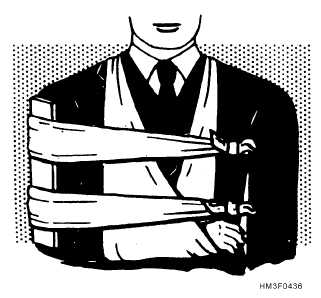of fracture. If the fracture is near the elbow, the arm is
likely to be straight with no bend at the elbow.
If the fracture is open, stop the bleeding and treat
the wound before attempting to treat the fracture.
NOTE:
Treatment of the fracture depends
partly upon the location of the break.
If the fracture is in the upper part of the arm near
the shoulder, place a pad or folded towel in the armpit,
bandage the arm securely to the body, and support the
forearm in a narrow sling.
If the fracture is in the middle of the upper arm, you
can use one well-padded splint on the outside of the
arm. The splint should extend from the shoulder to the
elbow. Fasten the splinted arm firmly to the body and
support the forearm in a narrow sling, as shown in
figure 4-36.
Another way of treating a fracture in the middle of
the upper arm is to fasten two wide splints (or four
narrow ones) about the arm and then support the
forearm in a narrow sling. If you use a splint between
the arm and the body, be very careful that it does not
extend too far up into the armpit; a splint in this
position can cause a dangerous compression of the
blood vessels and nerves and may be extremely painful
to the victim.
If the fracture is at or near the elbow, the arm may
be either bent or straight. No matter in what position
you find the arm, DO NOT ATTEMPT TO
STRAIGHTEN IT OR MOVE IT IN ANY WAY.
Splint the arm as carefully as possible in the position in
which you find it. This will prevent further nerve and
blood vessel damage. The only exception to this is if
there is no pulse distal to the fracture, in which case
gentle traction is applied and then the arm is splinted.
Treat the victim for shock and get him under the care of
a medical officer as soon as possible.
Thigh Fracture
The femur is the long bone of the upper part of the
leg between the kneecap and the pelvis. When the
femur is fractured through, any attempt to move the
limb results in a spasm of the muscles and causes
excruciating pain. The leg has a wobbly motion, and
there is complete loss of control below the fracture.
The limb usually assumes an unnatural position, with
the toes pointing outward. By actual measurement, the
fractured leg is shorter than the uninjured one because
of contraction of the powerful thigh muscles. Serious
damage to blood vessels and nerves often results from a
fracture of the femur, and shock is likely to be severe.
If the fracture is open, stop the bleeding and treat
the wound before attempting to treat the fracture itself.
Serious bleeding is a special danger in this type of
injury, since the broken bone may tear or cut the large
artery in the thigh.
Carefully straighten the leg. Apply two splints,
one on the outside of the injured leg and one on the
inside. The outside splint should reach from the armpit
to the foot. The inside splint should reach from the
crotch to the foot. The splints should be fastened in five
places: (1) around the ankle; (2) over the knee; (3) just
below the hip; (4) around the pelvis; and (5) just below
the armpit (fig. 4-37).
The legs can then be tied
together to support the injured leg as firmly as possible.
It is essential that a fractured thigh be splinted
before the victim is moved. Manufactured splints, such
as the Hare or the Thomas half-ring traction splints, are
best, but improvised splints may be used. Figure 4-37
shows how boards may be used as an emergency splint
for a fractured thigh. Remember, DO NOT MOVE
THE VICTIM UNTIL THE INJURED LEG HAS
BEEN IMMOBILIZED. Treat the victim for shock,
and evacuate at the earliest possible opportunity.
Lower Leg Fracture
When both bones of the lower leg are broken, the
usual signs of fracture are likely to be present. When
only one bone is broken, the other one acts as a splint
and, to some extent, prevents deformity of the leg.
However, tenderness, swelling, and pain at the point of
4-48
Figure 4-36.—Splint and sling for a fractured upper arm.

